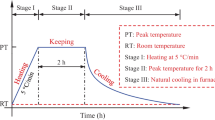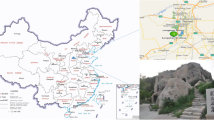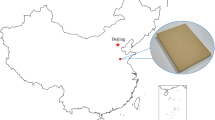Abstract
The surface roughness of rock directly affects its strength, deformation, and seepage characteristics. Understanding the change of rock surface roughness under the heating and cooling cycles is of great significance for evaluating the damage degree of rock and effectively predicting the instability of rock mass. In this paper, using grayish yellow sandstone as an example, we study the variation in the surface roughness of sandstone after different heating and cooling cycles by the arithmetical mean deviation of the profile (Ra) and the fractal dimension (D). The results show that the surface roughness of sandstone increases with the increase of temperature and cycles after heating and cooling; at above 500 °C, the thermal damage increased significantly due to the expansion and cracking of quartz particles, and the cycle causes the damage to accumulate, which further weakens the adhesion between particles, resulting in a significant increase in Ra and D value after 6 cycles; when the damage accumulates to a certain extent, some minerals fall off from the surface of sandstone, resulting in the decrease of Ra and D value. We also found that there is a correlation between Ra and the D value; that is, Ra increases exponentially with increases in the D value. The research results of this paper are of great significance to the rock mass engineering under the condition of heating and cooling cycles and can be used to monitor the stability of rock mass.









Similar content being viewed by others
References
Andrade PS, Saraiva AA (2008) Estimating the joint roughness coefficient of discontinuities found in metamorphic rocks. Bull Eng Geol Environ 67(3):425–434
Babanouri N, Karimi S, Sarafrazi, Soroor (2013) A hybrid particle swarm optimization and multi-layer perceptron algorithm for bivariate fractal analysis of rock fractures roughness. Int J Rock Mech Min Sci 60(60):66–74
Barla G (2016) Comprehensive study including testing, monitoring and thermo-hydro modelling for design and implementation of a geothermal system in Torino (Italy). Geomech Geophys Geo-Energy Geo-Resour 3:1–14
Barton N, Choubey V (1977) The shear strength of rock joints in theory and practice. Rock Mech 10(1–2):1–54
Belem T, Homand-Etienne F, Souley M (1997) Fractal analysis of shear joint roughness. Int J Rock Mech Min Sci 34(3):395–398
Breede K, Dzebisashvili K, Liu X, Falcone G (2013) A systematic review of enhanced (or engineered) geothermal systems: past, present and future. Geotherm Energy Sci 1(1):4
Cao O, Luo L, Liu TY, Zhang K (2011) Analysis of the fractal and sample size effects of the rock joint surface roughness. Sci Technol Rev 29(24):57–61
Cervenka J, Chandra Kishen JM, Saouma V (1998) Mixed mode fracture of cementitious bimaterial interfaces; part II: numerical simulation. Eng Fract Mech 60(1):95–107
Clarke KC (1986) Computation of the fractal dimension of topographic surfaces using the triangular prism surface area method. Comput Geosci 12(5):713–722
Dong Z, Sun Q, Ranjith PG (2019) Surface properties of grayish-yellow sandstone after thermal shock. Environ Earth Sci 78(14):420
Du SG, Chen Y, Fan LB (1996) Mathematical expression of JRC modified straight-edge method. J Eng Geol 4(2):36–43
Frédérique B, Lopez J (2000) Watershed lines and catchment basins: a new 3D-motif method. Int J Mach Tools Manuf 40(8):1171–1184
Ge YF, Tang HM, Wang LQ (2016) Anisotropy, scale and interval effects of natural rock discontinuity surface roughness. Chin J Geotech Eng 38(1):170–179
Grasselli G, Egger P (2003) Constitutive law for the shear strength of rock joints based on three-dimensional surface parameters. Int J Rock Mech Min 40(1):25–40
Hartlieb P, Toifl M, Kuchar F, Meisels R, Antretter T (2015) Thermo-physical properties of selected hard rocks and their relation to microwave-assisted comminution. Miner Eng 91:34–41
Heaney PJ (1994) Structure and chemistry of the low-pressure silica polymorphs. Rev Mineral Geochem 29(1):1–40
Heard HC, Page L (1982) Elastic moduli, thermal expansion, and inferred permeability of two granites to 350 °C and 55 megapascals. J Geophys Res Solid Earth 87(B11):9340–9348
Hetherington J, Thambimuthu K (2003) In-situ gasification, enhanced methane recovery and CO2 storage in deep coal seams. Greenh Gas Control Technol-6th Int Conference. Pergamon 1:709–716
Kulatilake PHSW, Fellow AJU, Panda BB, Nghiem N (1999) Development of new peak shear strength criterion for anisotropic rock joints. Int J Rock Mech Min Sci 125(9):1010–1017
Lee YH, Carr JR, Barr DJ, Haas CJ (1990) The fractal dimension as a measure of the roughness of rock discontinuity profiles. Int J Rock Mech Min Sci Geomech Abstr 27(6):453–464
Moss GW (1999) Mathematical models of the alpha-beta phase transition of quartz. Dissertation. Virginia Polytech, I state U, Blacksburg, Virginia, USA
Nasseri MHB, Tatone BSA, Grasselli G, Young RP (2009) Fracture toughness and fracture roughness interrelationship in thermally treated westerly granite. Pure Appl Geophys 166(5–7):801–822
Navrotsky A (1994) Thermochemistry of crystalline and amorphous silica. Rev Mineral Geochem 29(1):309–329
Nowicki B (1985) Multiparameter representation of surface roughness. Wear 102(3):161–176
Ohno I (1995) Temperature variation of elastic constants of quartz across the α-β transition. Earth Planets Space 43(2):157–169
Somerton WH, Boozer GD (1960) Thermal characteristics of porous rocks at elevated temperatures. J Pet Technol 12(06):418–422
Takarli M, Prince W, Siddique R (2008) Damage in granite under heating/cooling cycles and water freeze–thaw condition. Int J Rock Mech Min Sci 45(7):1164–1175
Takeda M, Zhang M, Watanabe Y, Taneko N (2009) Applicability of analytical models to single-well permeability tests in deep and hydraulically tight geological formations. J Hydrol Eng 14(11):1200–1207
Tatone BSA, Grasselli G (2013) An investigation of discontinuity roughness scale dependency using high-resolution surface measurements. Rock Mech Rock Eng 46(4):657–681
Tester JW, Anderson BJ, Batchelor AS, Blackwell DD, DiPippo R, Drake EM, Garnish J, Livesay B, Moore MC, Nichols K (2007) impact of enhanced geothermal systems on US energy supply in the twenty-first century. Philos Trans R Soc Lond A 365(1853):1057–1094
Wang JN, Xie P (1997) Fractal evolution of surface roughness and mechanical behavior of rock joints under shearing. China J Geotech Eng 19(4):2–9
Xia CC (1996) A study on the surface morphological feathers of rock structural faces. J Eng Geol 4(3):71–78
Xie HP, Wang JA, Xie WH (1997) Fractal effects of surface roughness on the mechanical behavior of rock joints. Chaos, Solitons Fractals 8(2):221–252
Yi C, Zhang L, Chen ZH, Xie P (2007) A novel description of roughness surface with a modified fractal index Rd. J China Univ Min Technol 36(1):75–80
Zarichyak YP, Ramazanova AE, Emirov SN (2013) Contribution of thermal radiation in measurements of thermal conductivity of sandstone. Phys Solid State 55(12):2436–2441
Zhou HW, Xie P, Kwasniewski MA (2000) Fractal dimension of rough surface estimated by the cubic covering method. J Tribol 20(6):455–459
Zhu D, Jing H, Yin Q, Han G (2018) Experimental study on the damage of granite by acoustic emission after cyclic heating and cooling with circulating water. Processes 6(10):1–20
Funding
This research was supported by the National Natural Science Foundation of China (Grant No. 41672279, 41972288).
Author information
Authors and Affiliations
Corresponding author
Additional information
Responsible Editor: Zeynal Abiddin Erguler
Rights and permissions
About this article
Cite this article
Ge, Z., Sun, Q. & Zhang, N. Changes in surface roughness of sandstone after heating and cooling cycles. Arab J Geosci 13, 315 (2020). https://doi.org/10.1007/s12517-020-05295-w
Received:
Accepted:
Published:
DOI: https://doi.org/10.1007/s12517-020-05295-w




